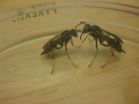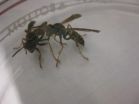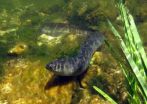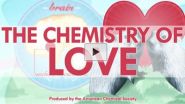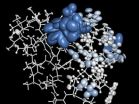Wasps use ancient aggression genes to create social groups
2014-02-10
(Press-News.org) Aggression-causing genes appeared early in animal evolution and have maintained their roles for millions of years and across many species, even though animal aggression today varies widely from territorial fighting to setting up social hierarchies, according to researchers from Iowa State University, Penn State and Grand Valley State University.
If these "mean genes" keep their roles in different animals and in different contexts, then perhaps model organisms -- such as bees and mice -- can provide insights into the biological basis of aggression in all animals, including humans, the researchers said.
"This is one of the first investigations to utilize large datasets consisting of thousands of different genes to ask whether there are shared genes relating to similar forms of behavior across a very wide range of animals," said Amy Toth, assistant professor of ecology, evolution and organismal biology, Iowa State. "Specifically, we looked at aggressive behavior in wasps, bees, fruit flies and mice and found a few genes that are consistently associated with aggression. This suggests that even after hundreds of millions of years of evolution, some genes may retain their ancestral roles in similar forms of behavior, like aggression."
The team investigated the expression of aggression genes in the brains and ovaries of paper wasps -- Polistes metricus. Specifically, they looked at wasps belonging to different castes including dominant colony-founding queens, subordinate colony-founding queens, established queens, dominant workers and subordinate workers. These individuals displayed widely different levels of reproductive dominance and, linked to that, aggressive behavior. The team then compared the wasp results to gene expression data already available in honey bees, fruit flies and mice.
"We found that in wasps, which are primitively social insects, aggression genes control the establishment of an individual's dominance over a group," said Christina Grozinger, professor of entomology and director of the Center for Pollinator Research, Penn State. "In contrast, in honey bees, which are advanced social insects, aggression genes control altruistic defensive behavior -- for example, when guard bees sting a predator or even a beekeeper, and die in the process. In solitary species, like fruit flies and mice, the same set of aggression genes controls fighting between males over territory. So the same genes are involved in aggression across species, but are now being used in different ways by different organisms."
According to Grozinger, the results suggest that model organisms -- such as bees and mice -- can be used to study aggression in humans because they share some of the same genes that regulate aggression behaviors, even if those behaviors are now quite different.
In addition to learning that aggression genes are shared among organisms, the team also found that these genes are extremely sensitive to the external environment.
"We found that the most important influence on expression of genes in the brains of paper wasps was external factors, such as the season and how large the colony was at the time," Toth said. "This indicates the important role of external cues in shaping the molecular processes that regulate behavior."
The results, which appear today (Feb. 10) in BMC Genomics, provide new insight into the debate between nature and nurture, according to Grozinger.
"Everyone agrees that both nature -- including genes and physiology -- and nurture -- including diet, environment and social interactions -- contribute to the likelihood that an individual will behave in a certain way or develop a disease," Grozinger said. "But our results show that the external environment plays a much greater role in regulating expression of genes in the brain, which ultimately regulates behavior, than physiology. This is very surprising."
The scientists plan to use their findings to conduct experiments in which they will manipulate the expression of single genes to see how they affect behavior.
"One thing we would like to investigate is what will happen if we ramp up expression of one of the genes involved in aggression," Toth said. "Can we create hyper-aggressive wasps? This type of question allows us to go beyond correlation between the gene and the behavior and address causation. Does the gene of interest actually cause aggressive behavior?"
Grozinger added, "If there are hyper-aggressive wasps, what effect does that have on wasp society?"
INFORMATION:
The U.S. Department of Agriculture-Agriculture and Food Research Initiative and the National Science Foundation supported this research.
Other authors on the paper include John Tooker, assistant professor of entomology, and Robert Minard, senior lecturer emeritus, Penn State; Srihari Radhakrishnan, Ph.D. student in bioinformatics and computational biology, Iowa State University; and Michael Henshaw, associate professor of biology, Grand Valley State University.
ELSE PRESS RELEASES FROM THIS DATE:
Dental care in school breaks down social inequalities
2014-02-10
A new survey conducted by the University of Copenhagen and the World Health Organization (WHO) is highlighting the role of schools in work to promote health and prevent disease.
"Children in Scandinavia generally have healthy teeth and gums, largely on account of dental care in schools for all children, the arrival of fluoride toothpaste on the market, a healthy lifestyle and high living standards. But the situation in the poorest countries of the world is very different to that in Scandinavia. However, it is positive to note that the WHO's Health Promoting Schools Initiative ...
Threatened eels disappear in the deep on their way to the Sargasso Sea
2014-02-10
When the threatened European eels cross the Atlantic Ocean to get to the Sargasso Sea to spawn, they swim in deep water. But this does not protect them from predators, researchers from the University of Southern Denmark report: Even in deep water the eels are hunted and eaten.
The European eel is in decline, and all over the world biologists are struggling to map its mysterious life cycle in order to bring its numbers back up. One of the great puzzles is why and how the eel each year travels thousands of kilometers to get to the Sargasso Sea to spawn.
A European monitoring ...
The chemistry of love: Valentine's Day science from ACS Reactions
2014-02-10
WASHINGTON, Feb. 10, 2014 — Love has inspired timeless songs and sonnets — not to mention a few less-than-timeless romantic comedies. Now the chemistry of love is the subject of the latest episode of the American Chemical Society's Reactions YouTube series (formerly Bytesize Science). Just in time for Valentine's Day, the video is available at http://youtu.be/bp7Ydv5wAPk.
The video explains how feel-good neurotransmitters like dopamine and oxytocin fuel lifelong pair bonds in prairie voles, which — along with humans — are the mammalian kingdom's leading monogamists. "If ...
Sometimes the average just isn't good enough
2014-02-10
This news release is available in German. When averaging is good and when it's not
Usually averaging is a good thing that can make life a lot easier. For example, when you eat out with a group of friends and it comes to paying. If everyone had a meal and a drink and you split the bill total by the number of people, everyone will pay pretty close to what they would have paid for their individual meal and drink. However, if some people had a starter, a steak for main, a dessert and champagne while you had spaghetti and a soft drink, you will feel pretty much ripped ...
Oil composition boost makes hemp a cooking contender
2014-02-10
Scientists at the University of York today report the development of hemp plants with a dramatically increased content of oleic acid. The new oil profile results in an attractive cooking oil that is similar to olive oil in terms of fatty acid content having a much longer shelf life as well as greater heat tolerance and potentially more industrial applications.
Researchers in the Centre for Novel Agricultural Products (CNAP) in the Department of Biology at York say that high oleic acid varieties are a major step towards developing hemp as a commercially attractive break ...
New therapy for personality disorders proven more effective than other major treatments
2014-02-10
A large scale randomized control trial, just released in the American Journal of Psychiatry (the official journal of the American Psychiatric Association) shows Schema Therapy to be significantly more effective than two major alternative approaches to the treatment of a broad range of personality disorders (avoidant, obsessive compulsive, dependent, paranoid, histrionic, and narcissistic). Schema Therapy resulted in a higher rate of recovery, greater declines in depression, greater increases in general and social functioning and had a lower drop out rate. The results also ...
EHR-based screening program for AAA cuts the number of at-risk men by more than half
2014-02-10
PASADENA, CALIF., Feb. 10, 2014 — A screening program for abdominal aortic aneurysms, integrated into an electronic health record, dramatically reduced the number of unscreened at-risk men by more than 50 percent within 15 months, according to a Kaiser Permanente study published today in the Journal of Vascular Surgery. An abdominal aortic aneurysm is a balloon-like bulge in the aorta, which – if ruptured – can result in death. It is estimated that more than one million Americans are living with undiagnosed AAA, according to the Society for Vascular Surgery.
Since 2005, ...
Is height important in matters of the heart? New study says yes
2014-02-10
Is height important in matters of the heart? According to new research from Rice University and the University of North Texas, the height of a potential partner matters more to women than men, and mostly for femininity and protection.
The study, "Does Height Matter? An Examination of Height Preferences in Romantic Coupling," was conducted in two parts. Part one, which used data from the Yahoo! personal dating advertisements of 455 males (average height of 5 feet 8 inches and average age of 36 years) and 470 females (average height of 5 feet 4 inches and average age of ...
Keep romance alive with double dates
2014-02-10
Austin – February 10, 2014 – Going on a double date may be more effective at reigniting passion in your own relationship than the classic candlelit dinner for two. According to new research, striking up a friendship with another couple in which you discuss personal details of your life will bring you closer to your own partner.
"Passionate love is one of the first dimensions of love to decrease in couples over time as the newness of a relationship begins to wane," says Keith Welker, a doctoral student at Wayne State University. "Relationships have widely been thought ...
Study suggests ways to improve common furniture fire test
2014-02-10
The bench-scale test widely used to evaluate whether a burning cigarette will ignite upholstered furniture may underestimate the tendency of component materials to smolder when these materials are used in sofas and chairs supported by springs or cloth, National Institute of Standards and Technology (NIST) and American University researchers report in a new study.*
The study comes as regulations and methods for evaluating the likelihood that soft-furniture materials will ignite are undergoing scrutiny. In November 2013, California removed an open-flame test from its furniture ...
